R Aquarii viewed by the Very Large Telescope and Hubble
PR Image eso1840d
R Aquarii In the constellation Aquarius
PR Image eso1840d
Digitized Sky Survey image around R Aquarii
Video
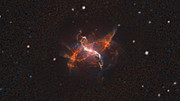
ESOcast 188 Light: Dancing with the Enemy
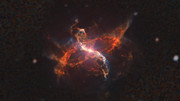
Zooming in on R Aquarii
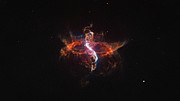
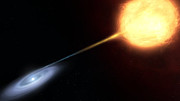
A vampiric star
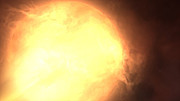
Close-up of a red giant star
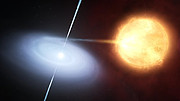
Jet outburst of a vampiric star
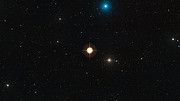

Changing brightness of R Aquarii
Close-up of jets
ESO’s R Aquarii Week continues with the sharpest R Aquarii image ever
While testing a new subsystem on the
SPHERE planet-hunting instrument on ESO’s Very Large Telescope,
astronomers were able to capture dramatic details of the turbulent
stellar relationship in the binary star R Aquarii with unprecedented
clarity — even compared to observations from Hubble.
This spectacular image — the second instalment in ESO’s R Aquarii Week — shows intimate details of the dramatic stellar duo making up the binary star R Aquarii.
Though most binary stars are bound in a graceful waltz by gravity, the
relationship between the stars of R Aquarii is far less serene. Despite
its diminutive size, the smaller of the two stars in this pair is
steadily stripping material from its dying companion — a red giant.
Years of observation have uncovered the peculiar story
behind the binary star R Aquarii, visible at the heart of this image.
The larger of the two stars, the red giant, is a type of star known as a
Mira variable.
At the end of their life, these stars start to pulsate, becoming 1000
times as bright as the Sun as their outer envelopes expand and are cast
into the interstellar void.
The death throes of this vast star are already dramatic, but the influence of the companion white dwarf
star transforms this intriguing astronomical situation into a sinister
cosmic spectacle. The white dwarf — which is smaller, denser and much
hotter than the red giant — is flaying material from the outer layers of
its larger companion. The jets of stellar material cast off by this
dying giant and white dwarf pair can be seen here spewing outwards from R
Aquarii.
<
Occasionally, enough material collects on the surface of the white dwarf to trigger a thermonuclear nova explosion,
a titanic event which throws a vast amount of material into space. The
remnants of past nova events can be seen in the tenuous nebula of gas
radiating from R Aquarii in this image.
<
R Aquarii lies only 650 light-years from Earth — a near neighbour in astronomical terms — and is one of the closest symbiotic binary stars
to Earth. As such, this intriguing binary has received particular
attention from astronomers for decades. Capturing an image of the myriad
features of R Aquarii was a perfect way for astronomers to test the
capabilities of the Zurich IMaging POLarimeter (ZIMPOL), a component on
board the planet-hunting instrument SPHERE. The results exceeded observations from space — the image shown here is even sharper than observations from the famous NASA/ESA Hubble Space Telescope.
<
SPHERE was developed over years of studies and construction to focus
on one of the most challenging and exciting areas of astronomy: the
search for exoplanets. By using a state-of-the-art adaptive optics system and specialised instruments such as ZIMPOL, SPHERE can achieve the challenging feat of directly imaging
exoplanets. However, SPHERE’s capabilities are not limited to hunting
for elusive exoplanets. The instrument can also be used to study a
variety of astronomical sources — as can be seen from this spellbinding
image of the stellar peculiarities of R Aquarii.
More Information
This research was presented in the paper “SPHERE / ZIMPOL
observations of the symbiotic system R Aqr. I. Imaging of the stellar
binary and the innermost jet clouds” by H.M. Schmid et. al, which was
published in the journal Astronomy & Astrophysics.
The team was composed of H. M. Schmid (ETH Zurich,
Institute for Astronomy, Switzerland), A. Bazzon (ETH Zurich, Institute
for Astronomy, Switzerland), J. Milli (European Southern Observatory),
R. Roelfsema (NOVA Optical Infrared Instrumentation Group at ASTRON, the
Netherlands), N. Engler (ETH Zurich, Institute for Astronomy,
Switzerland) , D. Mouillet (Université Grenoble Alpes and CNRS, France),
E. Lagadec (Université Côte d’Azur, France), E. Sissa (INAF and
Dipartimento di Fisica e Astronomia “G. Galilei” Universitá di Padova,
Italy), J.-F. Sauvage (Aix Marseille Univ, France), C. Ginski (Leiden
Observatory and Anton Pannekoek Astronomical Institute, the
Netherlands), A. Baruffolo (INAF), J.L. Beuzit (Université Grenoble
Alpes and CNRS, France), A. Boccaletti (LESIA, Observatoire de Paris,
France), A. J. Bohn (ETH Zurich, Institute for Astronomy, Switzerland),
R. Claudi (INAF, Italy), A. Costille (Aix Marseille Univ, France), S.
Desidera (INAF, Italy), K. Dohlen (Aix Marseille Univ, France), C.
Dominik (Anton Pannekoek Astronomical Institute, the Netherlands), M.
Feldt (Max-Planck-Institut für Astronomie, Germany), T. Fusco (ONERA,
France), D. Gisler (Kiepenheuer-Institut für Sonnenphysik, Germany),
J.H. Girard (European Southern Observatory), R. Gratton (INAF, Italy),
T. Henning (Max-Planck-Institut für Astronomie, Germany), N. Hubin
(European Southern Observatory), F. Joos (ETH Zurich, Institute for
Astronomy, Switzerland), M. Kasper (European Southern Observatory), M.
Langlois (Centre de Recherche Astrophysique de Lyon and Aix Marseille
Univ, France), A. Pavlov (Max-Planck-Institut für Astronomie, Germany),
J. Pragt (NOVA Optical Infrared Instrumentation Group at ASTRON, the
Netherlands), P. Puget (Université Grenoble Alpes, France), S.P. Quanz
(ETH Zurich, Institute for Astronomy, Switzerland), B. Salasnich (INAF,
Italy), R. Siebenmorgen (European Southern Observatory), M. Stute
(Simcorp GmbH, Germany), M. Suarez (European Southern Observatory), J.
Szulagyi (ETH Zurich, Institute for Astronomy, Switzerland), C. Thalmann
(ETH Zurich, Institute for Astronomy, Switzerland), M. Turatto (INAF,
Italy), S. Udry (Geneva Observatory, Switzerland), A. Vigan (Aix
Marseille Univ, France), and F. Wildi (Geneva Observatory, Switzerland).
ESO is the foremost intergovernmental astronomy
organisation in Europe and the world’s most productive ground-based
astronomical observatory by far. It has 16 Member States: Austria,
Belgium, the Czech Republic, Denmark, France, Finland, Germany, Ireland,
Italy, the Netherlands, Poland, Portugal, Spain, Sweden, Switzerland
and the United Kingdom, along with the host state of Chile and with
Australia as a Strategic Partner. ESO carries out an ambitious programme
focused on the design, construction and operation of powerful
ground-based observing facilities enabling astronomers to make important
scientific discoveries. ESO also plays a leading role in promoting and
organising cooperation in astronomical research. ESO operates three
unique world-class observing sites in Chile: La Silla, Paranal and
Chajnantor. At Paranal, ESO operates the Very Large Telescope and its
world-leading Very Large Telescope Interferometer as well as two survey
telescopes, VISTA working in the infrared and the visible-light VLT
Survey Telescope. ESO is also a major partner in two facilities on
Chajnantor, APEX and ALMA, the largest astronomical project in
existence. And on Cerro Armazones, close to Paranal, ESO is building the
39-metre Extremely Large Telescope, the ELT, which will become “the
world’s biggest eye on the sky”.
Links
Contacts
Calum Turner
ESO Public Information Officer
Garching bei München, Germany
Tel: +49 89 3200 6670
Cell: +49 151 1537 3591
Email: pio@eso.org
Source: ESO/News




